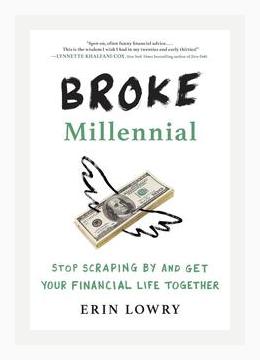Finance and AccountingPersonal Finance
**
Table of Contents:
1. Introduction
2. Money Mindset
3. Understanding Your Financial Situation
4. Budgeting
5. Managing Debt
6. Saving and Investing
7. Dealing with Family and Friends about Money
8. Conclusion
1. Introduction
Erin Lowry’s “Broke Millennial” is a personal finance guide specifically aimed at millennials who find themselves struggling to manage their finances. Lowry’s book is structured to take readers from feeling financially insecure to becoming financially savvy through actionable advice and real-life examples.
2. Money Mindset
Lowry begins by emphasizing the importance of adopting a healthy money mindset. She articulates that money shouldn’t be a taboo topic and encourages open discussions about finances. She believes financial literacy begins with understanding one’s attitudes and beliefs about money.
Actionable Tip: Conduct a Money Attitude Assessment
1. Reflect on how your parents handled money and how their behavior has influenced your financial habits.
2. Write down your earliest money memories and how they make you feel.
3. Identify any negative beliefs about money and consciously work to reframe them positively.
3. Understanding Your Financial Situation
Lowry insists that the first step in gaining control over finances is understanding your current financial situation. She provides guidance on assessing one’s net worth and cash flow.
Actionable Tip: Calculate Your Net Worth
1. List all your assets (savings, investments, properties) and their values.
2. List all your liabilities (student loans, credit card debt, mortgage).
3. Subtract the total liabilities from total assets to find your net worth.
Example: If you have \$10,000 in savings, a \$15,000 car, a \$5000 student loan, and \$2000 in credit card debt, your net worth would be:
(\$10,000 + \$15,000) – (\$5000 + \$2000) = \$18,000
4. Budgeting
One of the book’s core topics is budgeting. Lowry suggests the zero-sum budget, where every dollar is assigned a purpose.
Actionable Tip: Create a Zero-Sum Budget
1. Begin with your monthly income.
2. List all your expenses, including savings and investments.
3. Ensure the sum of your expenses equals your income by the end of each month.
Example: If you earn \$3000 a month, allocate each dollar:
– Rent: \$900
– Groceries: \$400
– Utilities: \$150
– Savings: \$400
– Student Loans: \$300
– Entertainment: \$150
– Miscellaneous: \$700
5. Managing Debt
Lowry dedicates significant attention to managing student loans and other forms of debt, introducing the debt snowball and debt avalanche methods.
Actionable Tip: Choose and Implement a Debt Repayment Strategy
– Debt Snowball: Pay off smallest debts first for quick wins.
– Debt Avalanche: Pay off debts with the highest interest rates first to save money over time.
Example:
– If you have three debts: \$1000 at 5%, \$3000 at 7%, and \$5000 at 4%.
– Debt Snowball: Prioritize the \$1000 debt, then \$3000, and finally the \$5000.
– Debt Avalanche: Prioritize the \$3000 debt, then \$1000, and finally the \$5000.
6. Saving and Investing
Lowry discusses the importance of building an emergency fund and introduces basic investment concepts, recommending starting with a safety net of 3 to 6 months’ worth of living expenses.
Actionable Tip: Start an Emergency Fund
1. Calculate your monthly expenses.
2. Open a high-yield savings account.
3. Set up automatic transfers to this account until you reach your goal.
Example: If your monthly expenses are \$2000, aim to save between \$6000 and \$12,000.
Investing: Lowry demystifies investing by explaining different types of accounts (like 401(k)s and IRAs) and investment vehicles (such as stocks, bonds, and mutual funds).
Actionable Tip: Open a Retirement Account
1. Check if your employer offers a 401(k) and enquire about matching contributions.
2. If not, open an IRA (Roth or Traditional based on your tax situation).
3. Contribute a fixed percentage of your income monthly.
Example: If your employer matches up to 4% of your salary, contribute at least 4% to take full advantage.
7. Dealing with Family and Friends about Money
Lowry highlights the complexities of navigating financial discussions with family and friends. She provides advice on handling shared expenses and loans, stressing clear communication and setting boundaries.
Actionable Tip: Set Clear Financial Boundaries
1. When lending money, be clear about repayment terms.
2. Discuss shared expenses openly to avoid misunderstandings.
3. Learn to say “no” if a request jeopardizes your financial health.
Example: If a friend asks for a loan, instead of giving cash, you can offer to help them create a budget or connect them with financial resources.
8. Conclusion
In “Broke Millennial,” Erin Lowry provides a comprehensive guide to improving financial literacy and taking actionable steps towards financial independence. Each chapter is filled with relatable anecdotes and real-life examples that make the advice practical and easy to implement.
Final Actionable Tip: Develop a Continuous Learning Approach
– Regularly review and adjust your budget.
– Stay informed about personal finance trends and tips by reading books, blogs, and attending workshops.
– Set financial goals annually and track progress.
By following Lowry’s structured advice, readers can move from a place of financial uncertainty to one of empowerment and security, gradually paving their path to financial stability and success.
This structured summary encapsulates the main points and actionable advice from Erin Lowry’s “Broke Millennial,” offering a clear roadmap for readers seeking to improve their financial health.
